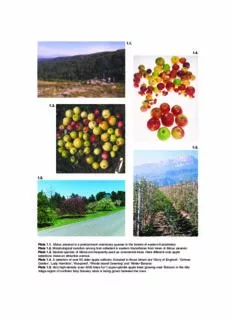
Apples : botany, production, and uses PDF
Preview Apples : botany, production, and uses
1.1. 1.4. 1.2. 1.5. 1.3. Plate1.1. Malus sieversiiis a predominant overstorey species in the forests of eastern Kazakhstan. Plate1.2.Morphological variation among fruit collected in eastern Kazakhstan from trees of Malus sieversii. Plate1.3.Several species of Malusare frequently used as ornamental trees.Here different crab apple selections make an attractive avenue. Plate1.4.A selection of over 50 older apple cultivars.Included in those shown are ‘Glory of England’, ‘Grimes Golden’, ‘Lady Hamilton’, ‘Nonpareil’, ‘Rhode Island Greening’and ‘Winter Banana’. Plate1.5.Very high-density (over 4000 trees ha-1) super-spindle apple trees growing near Bolzano in the Alto Adige region of northern Italy.Nursery stock is being grown between the rows. 1.6. 1.7. 1.8. 1.10. 1.9. Plate 1.6.High-density slender-spindle apple trees, typically planted with 3.0–3.5 m between rows and 1.0–1.25 m within the rows, growing in The Netherlands. Plate 1.7.Semi-intensive ‘Royal Gala’apples, trained as centre-leader trees and typically grown with 5 m x 3 m spacings, in Hawke’s Bay, New Zealand.Moderate year-round conditions, high sunshine hours and deep fertile soils make this one of the most productive apple-producing regions of the world. Plate 1.8.Semi-intensive centre-leader-trained apple trees growing near Grabouw in South Africa.Hot summer conditions and mild winters allow the commercial production of both apples (foreground) and citrus (background) in the same area. Plate 1.9.Large ‘Rome Beauty’trees on seedling rootstock, planted with 7.5 m x 7.5 m spacings in Ohio, exemplify older plantings in the USA. Plate 1.10.Extensive apple plantings, primarily of ‘Red Delicious’, trained as centre-leader trees, in Washington State, USA.High summer and cold winter temperatures typify the growing conditions in this arid, continental region. 3.1. 1.11. 3.2. 3.4. 3.3. Plate 1.11.Production in China, now the world’s largest producer of apples (20 million t in 2001).These 5-year-old ‘Fuji’trees on Malus prunifoliarootstock, are planted at 4 m x 3 m spacing.Vegetables are being cultivated between the rows. Plate3.1.Modern breeding programmes generate many hundreds of progeny from each cross between selected parents.Large land areas are needed to accommodate the seedling populations, which, because of the need to grow through a juvenile phase, may need to be maintained for several years before the onset of flowering and the initial evaluation of potential value. Plate3.2.Progeny arising from one cross can produce a very diverse range of fruit types – including different sizes, colours and shapes. Plate3.3.‘Pacific Rose’. Plate3.4.‘Sci’fresh apples now being marketed as ‘Jazz’. 3.5. 4.1. 4.3. 4.2. 4.4. Plate3.5.Colour sports of ‘Gala’developed naturally as mutations. Plate4.1.‘Delicious’, unspecified red strain (from Bruce Barritt). Plate4.2.‘Golden Delicious’, Reinders strain (from Praktijkonderzoek Plant and Omgeving, The Netherlands). Plate4.3.‘Fuji’(from Agriculture and Agri-Food Canada). Plate4.4.‘Granny Smith’(from Bruce Barritt). 4.5. 4.6. 4.7. 4.9. 4.8. Plate4.5.‘Imperial Gala’(from Bruce Barritt). Plate4.6.‘Jonathan’(from Praktijkonderzoek Plant and Omgeving, The Netherlands). Plate4.7.‘Jonagold’(from Praktijkonderzoek Plant and Omgeving, The Netherlands). Plate4.8.‘McIntosh’(from Bruce Barritt). Plate4.9.‘Rome Beauty’, unspecified red strain (from Agriculture and Agri-Food Canada). 4.11 4.10. 5.2. 4.12. 5.1. Plate4.10.‘Braeburn’(from Praktijkonderzoek Plant and Omgeving, The Netherlands). Plate4.11.‘Elstar’(from Bruce Barritt). Plate 4.12.‘Cox’s Orange Pippin’(from Bruce Barritt). Plate5.1.Bed system of apple scions growing on M.27 rootstock in the UK. Plate 5.2.A typical three-row bed system of ‘Queen Cox’apples planted on M.9 EMLA rootstocks in the UK. 5.3. 6.3. 5.4. 6.1. 6.2. Plate5.3.Two-row system of seventh-leaf ‘Granny Smith’on M.26 rootstock in the USA. Plate5.4.Traditional vigorous 40-year-old trees of the cultivar ‘Early Victoria’on seedling rootstocks. Plate6.1.Obliquely planted M.9 liners as starting material for a new layer bed. Plate 6.2.Example of a machine for harvesting rooted plants from a layer bed. Plate 6.3.Layer bed of M.9:at the right, first season:at the left, second season. 6.4. 6.5. 6.6. 6.7. 6.8. Plate 6.4.Mature layer bed of M.9. Plate 6.5.Bundles of rootstock hardwood cuttings harvested after bedding for 1 year in the nursery. Plate 6.6.Hard-pruned hedges of apple rootstocks. Plate 6.7.In vitromicropropagated apple shoots prior to subculturing. Plate 6.8.‘Starkspur Golden Delicious’, rooted in vitro. 6.9. 6.11. 6.10. 6.12. 6.13. Plate 6.9.Ex-micropropagated ‘Starkspur Golden Delicious’in the orchard 4 years after being planted as a small whip.Note the lack of fruits. Plate 6.10.One-year-old trees of ‘Red Boskoop’on M.9.Trees from left to right:unsprayed, or sprayed eight times (weekly) with 50, 100, 300 or 600 p.p.m.benzyladenine, respectively, to improve feathering. Plate6.11.‘Snip’tree of ‘Elstar’on M.9.Tree made from a table graft and cut back at 50 cm after the first nursery year. Plate 6.12.Productive interstem tree of ‘Elstar’on M.9 in the second leaf in the orchard. Plate 6.13.Chip budding. 9.1. 6.14. 9.2. 8.1. 9.3. Plate6.14.Tying the chip to the rootstock. Plate 8.1.Detailed monitoring of soil-moisture status and tree transpiration rates in experimental systems improves knowledge of apple tree water use.Enhanced water-use efficiency through better irrigation scheduling can result from such studies. Plate 9.1.Whole-tree gas-exchange chambers used for determined photosynthesis rates of intact apple canopies. Impacts of factors such as water stress and crop load can be assessed through using such sophisticated equipment. Plate 9.2.Fish-eye photograph used to assess canopy openness and light penetration as influenced by training system or pruning. Plate 9.3.Reflective mulch used under ‘Fuji’trees to improve fruit colour.
